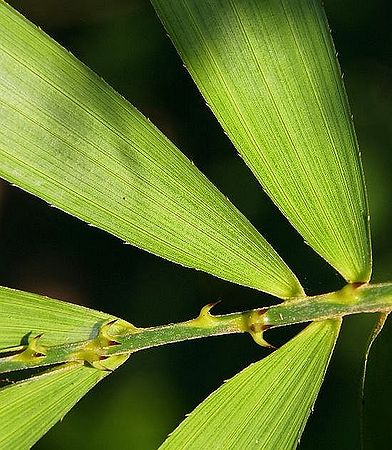Calamus paspalanthus
| Calamus (KAL-ah-muhs) paspalanthus (pahs-pahl-AHN-tuhs) | |||||||
|---|---|---|---|---|---|---|---|
 | |||||||
| Scientific Classification | |||||||
| |||||||
| Synonyms | |||||||
|
| |||||||
| Native Continent | |||||||
|
| |||||||
| Morphology | |||||||
| |||||||
| Culture | |||||||
|
| |||||||
| Survivability index | |||||||
|
| |||||||
| Common names | |||||||
|
| |||||||
Contents
Habitat and Distribution
Borneo. Rare in Brunei; elsewhere throughout Borneo, local in Peninsular Malaysia.
Description
Solitary moderate rattan, usually short-stemmed but rarely climbing to 20 m, frequently flopping to the ground and producing roots at a position about 1 cm below each node; stem without sheaths 10-15 mm in diam., with sheaths to about 40 mm in diam., internodes usually rather short to 12 cm long. Sheath dull dark purplish-brown due to abundant persistent scales, armed with large dark spines 3-5 cm long except around the sheath mouth where very much larger and ± erect to 10 cm; knee very conspicuous, bulbous, grossly swollen; ocrea very long, up to about 1 m, straw-coloured, fragile and papery, quickly disintegrating to leave almost no trace. Flagellum to 2 m long. Leaf ecirrate, to 2 m including petiole to 80 cm, but often much less; rachis covered with red-brown hairs; leaflets numerous, up to 100 on each side of the rachis, very close and regular, delicate in texture, to 30 × 1 cm, densely bristly on the lower surface. Inflorescences to 5 m or more, including the terminal flagellum; bracts tightly sheathing at the base but thin, papery and disintegrating at the tips; rachillae held at right angles to the partial inflorescence axis. Flowers strictly distichous. Fruit ± spherical, to 18 × 16 mm, covered in c. 15 vertical rows of smooth, red-brown scales with paler shiny margins. Seed ± anvil-shaped with two sharp wings, the sarcotesta extremely sour. Seedling leaf pinnate with numerous leaflets and reddish-brown hairy rachis. (J. Dransfield, The Rattans of Brunei Darussalam. 1997)/Palmweb. Editing by edric.
C. paspalanthus is such a strange species that there should be no difficulty in distinguishing it. (J. Dransfield, The Rattans of Brunei Darussalam. 1997)/Palmweb.
Culture
Comments and Curiosities
Etymology: Referring to the superficial resemblance of the male rachillae in flower, to a grass inflorescence.
Uses: The cane is ± useless as it shrinks and is frequently marred by the adventitious roots. The fruit is usually much appreciated for its sourness. Seedlings would make fine ornamentals.
- IMAGE GALLERY
External Links
References
Phonetic spelling of Latin names by edric.
Special thanks to Geoff Stein, (Palmbob) for his hundreds of photos.
Special thanks to Palmweb.org, Dr. John Dransfield, Dr. Bill Baker & team, for their volumes of information and photos.
Glossary of Palm Terms; Based on the glossary in Dransfield, J., N.W. Uhl, C.B. Asmussen-Lange, W.J. Baker, M.M. Harley & C.E. Lewis. 2008. Genera Palmarum - Evolution and Classification of the Palms. Royal Botanic Gardens, Kew. All images copyright of the artists and photographers (see images for credits).
J. Dransfield, The Rattans of Brunei Darussalam. 1997
Many Special Thanks to Ed Vaile for his long hours of tireless editing and numerous contributions.












